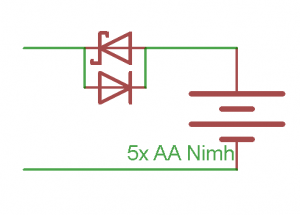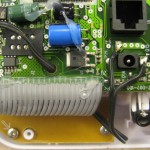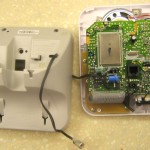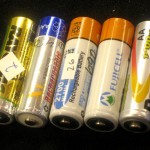Our cordless phone/answering machine is great – 5.8GHz so it doesn’t mess with wi-fi, multiple handsets, white so it fits into the kitchen decor (a MUST). But when the power goes out it forgets the time and date. (It does remember messages, which is good.)
To avoid the occasional annoyance of having to set the dumb time/date, I thought it should have a backup battery. OK – I need connections inside the phone and some kind of battery pack. What should I use?
Under load, the wall wart powering the phone puts out 6.8V. Five (1.2V) Nimh cells put out 6.0V, so that might work. Let’s see – 6.8V/5=1.36V. That’s just about the teminal voltage of a fully charged cell, so I can very likely just put the cells across the current power supply and it would work fine. The power supply never puts out more than 5 fully charged cells, so they shouldn’t be overcharged.
If I wanted to be a little more conservative, I could put a normal silicon diode back to back with a schottky diode and put the pair in series with the battery. The 0.7V drop across the normal diode would reduce the charging voltage to 6.1V, or ~1.22V/cell. That could not possibly overcharge them. It would cost the shottky’s 0.3V drop in the output – 5.7V while the cells were at their nominal 1.2V/cell. That would probably keep things running.Would AA cells hold up for long enough? I measured the current draw at full 6.8V: 10-20mA – even with the radio on! (How do they do that?) New AA cells are good for at least 2000 mAhr – 100 hours of backup. That’s overkill. But I have a box of AA cells to be recycled, and found 5 that still had 500-700 mAhr capacity. (It’s nice to have discharge test equipment!) That’s still more than a day – and they’re free! Sounds like a plan.
Connecting right across the coax power jack inside was easy. There was a convenient hole I could run the wire out through, and I put an RCA female on the end. Now all I need is a battery!
- Wires across power jack
- The whole thing
- Candidate cells
Buying holders for the rag-tag collection of cells I’d selected seems inappropriate. A nice minimalist approach is to connect the end of the cells together directly. Soldering directly to cell caps sorta works, but almost certainly causes damage to the cell. (And these are on their last legs anyway.) If I only had a battery tab welder! I guess I better bump that project up the priority list some more.
More to follow when I’ve made the battery.




